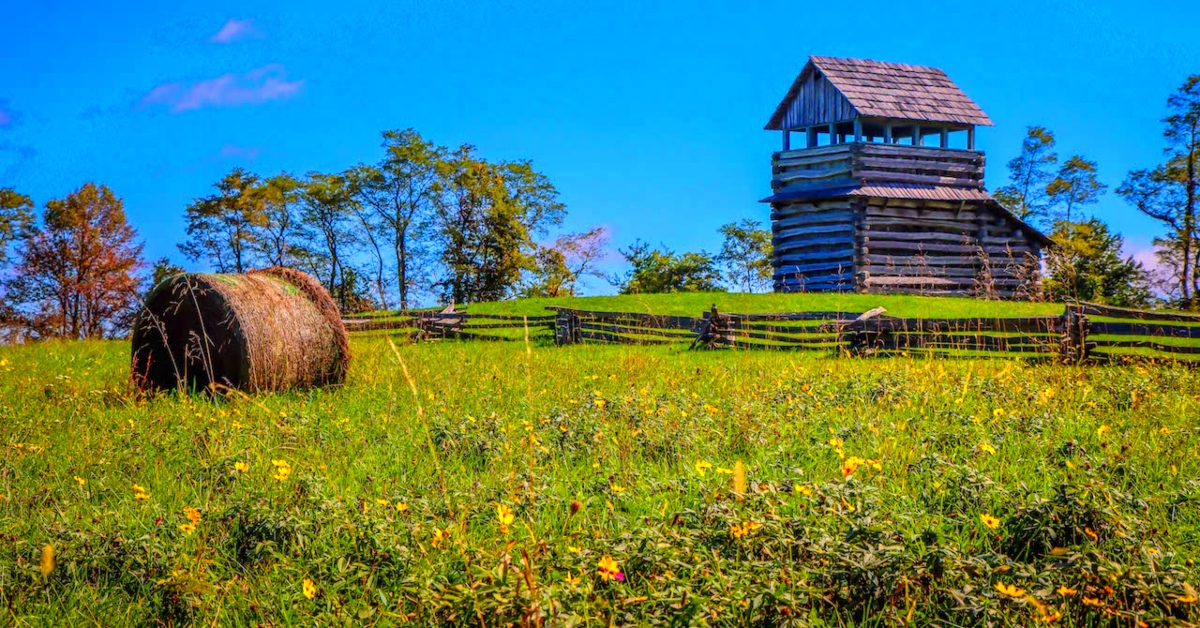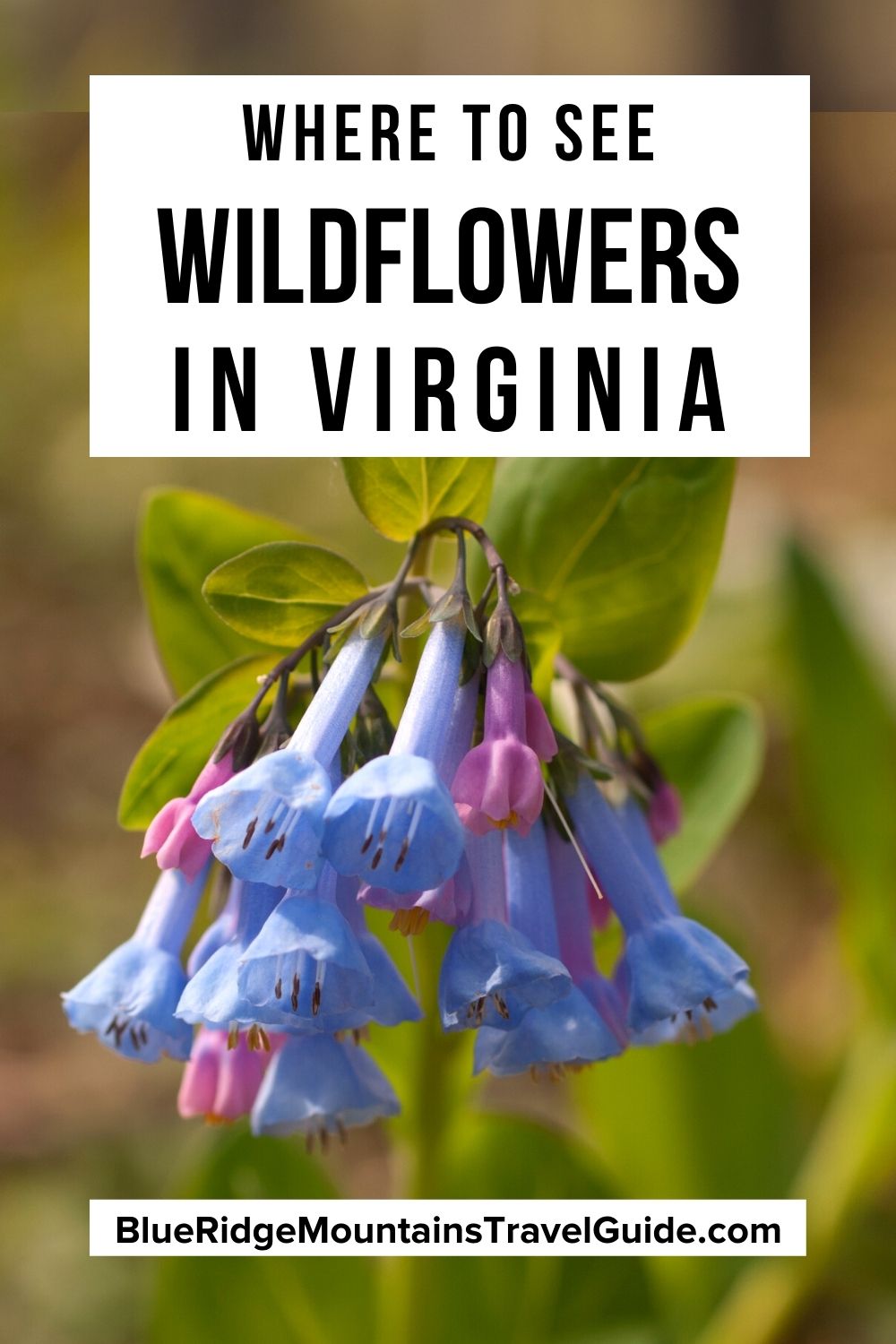The Blue Ridge Mountains of Virginia offer a rich, biodiverse terrain with lots of mountain streams, waterfalls, high-altitude meadows, and extensive forests.
It’s a perfectly fertile place for the beautiful Virginia wildflowers to flourish.
Not only is this an ideal setting for catching amazing scenic vistas and spotting wildlife, but the many microclimates found within the Virginia mountains mean that the area’s plant life is out-of-this-world.
One of the most exciting features of any collection of plants are the ones that put on flashy displays of color, and the flowers in Virginia are truly a collection of colorful stunners.
To become more familiar with what to keep an eye out for when you visit Virginia, here’s a sampling of the most beautiful wildflowers in Virginia, including tips on where you’re likely to see them.
READ MORE: The 10 Best Virginia State Parks in the Blue Ridge Mountains
Wildflowers in Virginia Guide
- Bee Balm/Wild Bergamot (Monarda spp.)
- Bloodroot (Sanguinaria canadensis)
- Butterfly Weed (Asclepias tuberosa)
- Canada Lily (Lilium canadanesis)
- Catawba Rhododendron (Rhododendron catawbiense)
- Common Rose Pink (Sabatia angularis)
- Eastern Redbud (Cercis canadensis)
- Flame Azalea (Rhododendron calendulaceum)
- Foxglove Beardtongue (Penstemon digitalis)
- Grass of Parnassus (Parnassia asarifolia)
- Great Blue Lobelia/Cardinal Flower ((Lobelia siphilitica/Lobelia cardinalis)
- Green-Headed Coneflower (Rudbeckia laciniate)
- Lanceleaf Coreopsis (Coreopsis lanceolate)
- Meadow Rue (Thalictrum aquilegiifolium)
- Nodding Ladies’ Tresses (Spiranthes cernua)
- Pinesap (Montropa hypopithus)
- Trillium (Trillium spp)
- Trout-Lily (Erythronium americanum)
- Virginia Bluebell (Mertensia virginica)
- Whorled Wood Aster (Aster accuminatus)
Native Flowers of Virginia
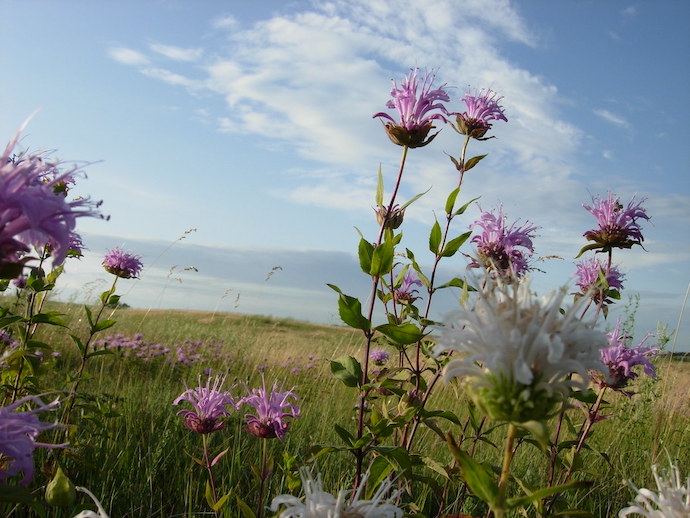
1. Bee Balm/Wild Bergamot
(Monarda spp.)
There are several versions of bee balm and wild bergamot that grow in the Blue Ridge Mountains and parts of Virginia. They are common, but in the most uncommonly beautiful of ways.
These plants are members of the mint family, which are famed for their ability to spread like wildfire and create aromatic oases.
Bee balm and wild bergamot add the allure of standing quite tall— at heights reaching four to five feet—and bursting into puffs of purple, lavender, and red.
These wildflowers make their homes in meadows, fields, and roadside verges. And they often show up in massive clusters that are cause for a pause.
READ MORE: The 10 Best Things to Do in Roanoke VA
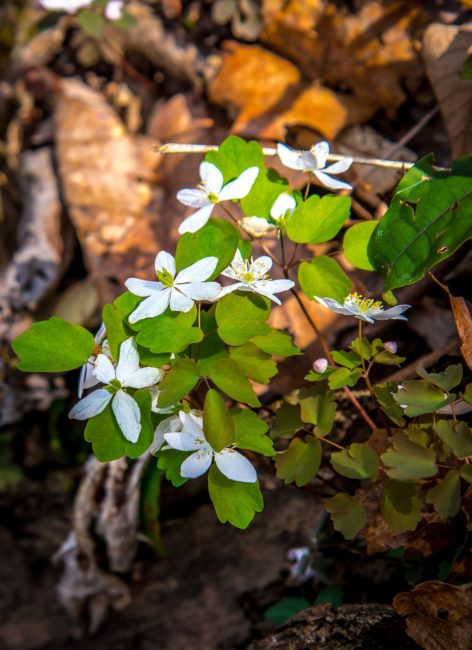
2. Bloodroot
(Sanguinaria canadensis)
One of the earliest spring wildflowers to bloom in Virginia, bloodroot flowers are often spotted around March.
These low-lying members of the poppy family appreciate the sunnier sections of deciduous forest, especially before the emerging leaves shade everything out.
These flowers have six or more white petals, and they like to open in the daytime and close up at night.
The rather ominous name is derived from a red secretion that comes from the root, which has traditionally been used as both a medicine and a dye.
READ MORE: The 7 Best Restaurants in Roanoke VA (Virginia’s Blue Ridge)

3. Butterfly Weed
Asclepias tuberosa
Most popularly recognized as a food source for the beloved Monarch butterfly, butterfly milkweed is beautiful in its own right.
Butterfly weed is drought-tolerant and prefers drier soil, where its taproot won’t rot. It also ikes plenty of sun.
The flowers of this species of milkweed are a showy orange, and typically appear in multi-stemmed clumps in July and August.
The orange wildflower grows in open fields, sunny forest edges, and highway waysides, and was named Virginia’s wildflower of the year in 1992.
READ MORE: The 20 Best Blue Ridge Parkway Overlooks in NC & VA

4. Canada Lily
(Lilium canadanesis)
Despite a name that might suggest otherwise, the ever-popular Canada lilies are native flowers in VA, and they are truly showstoppers.
The plants stand up to five feet tall and have whorls of elongated leaves. The flowers are located at the top of the plant and have six petals each.
Canada lilies appear plain red on their backs. They hang down, opening on the underside, with the petals curving back and upwards.
But then there’s a color explosion underneath, moving into oranges and vibrant yellows with dark specks.
The Canada lily is commonly seen throughout the Appalachian range, particularly along stream banks, and they bloom in the summertime.
READ MORE: The Appalachian Culture & History of the Blue Ridge Mountains
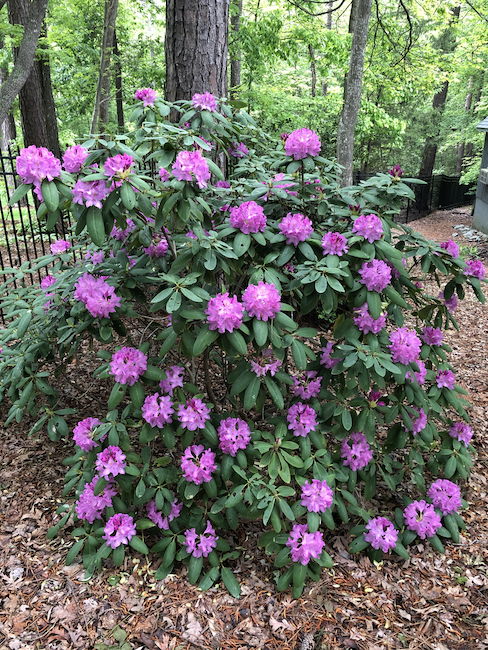
5. Catawba Rhododendron
(Rhododendron catawbiense)
A common (but always exciting) sight along the Blue Ridge Parkway, the Catawba Rhododendron also goes by names like mountain rosebay, purple rhododendron, and red laurel.
A stellar specimen of the rhododendron family, this species can get up to 15 feet tall with a similar spread, and it has evergreen foliage.
The flowers are violet, a couple of inches wide, and form in clusters. They are one of the classic spring blooms in the Blue Ridge region.
Rhododendrons love moisture-rich environments in the forest, such as alongside mountain streams and dangling dazzlingly over waterfalls.
READ MORE: The 15 Best Lakes in the Virginia Mountains to Visit
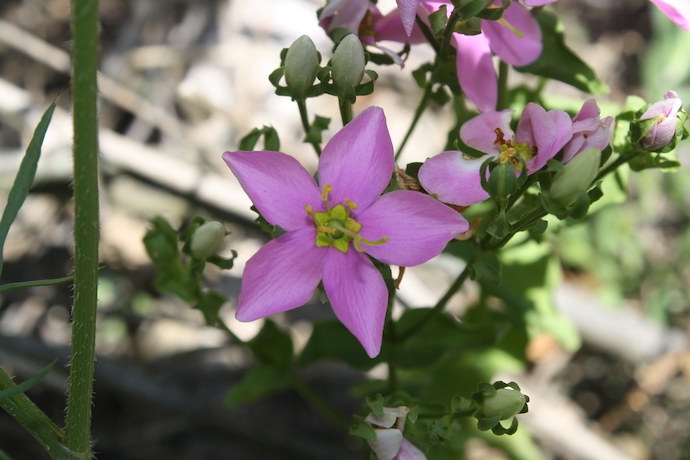
6. Common Rose Pink
(Sabatia angularis)
Neither roses nor common, the common rose pink is a native Virginia flower that plays perfectly with the visually stunning and fragrantly alluring.
Rose pink is common along the eastern coast of the US and Canada all the way west to New Mexico, where it puts on showy displays of one-inch flowers.
The flowers of the common rose pink are pink with yellow, star-shaped centers, and they appear as single, individual blooms amongst hundreds of others.
Rose pink thrives in more open areas, such as mountain meadows, where it can get plenty of sunshine.
READ MORE: Camping and Hiking in Grayson Highlands State Park, VA

7. Eastern Redbud
(Cercis canadensis)
Eastern redbuds are small flowering trees native throughout Virginia and Appalachia. In the spring, they provide some of the most eye-catching flowers around.
Oddly enough, redbud blooms are actually a vibrant pink, and they form in dense clusters all over the trees’ branches. They stand out, especially, because the flowers always come before the leaves.
These trees love to grow in forests as understory plants, and they often show up—like many understory species—along forest edges, often along roadways and hiking trails.
Another fun fact about redbuds is that the flowers are edible, surprisingly delicious, and a good source of vitamin C.
READ MORE: Camping and Hiking in Natural Bridge State Park, VA

8. Flame Azalea
(Rhododendron calendulaceum)
In the same family as mountain laurel and rhododendron (two blooms which are worthy of note in their own right), the flashy flame azalea is a pleasure to find in the deep forest.
These large understory shrubs like to light the landscape on fire in late spring.
They have bright orange blooms that radiate through the dappled shade of hardwood canopies, like a burst of brilliant fall colors among the verdant green.
The funnel-shaped flowers bloom in clusters of at least five, and they really stick out when the foliage of the shrub has only just begun to arrive.
Though mountain laurel and rhododendron are evergreens, such is not the case with azaleas. All native plants in Virginia are deciduous, meaning they shed their leaves annually in the autumn.
READ MORE: Tips for Tackling the McAfee Knob Hike Near Roanoke, Virginia
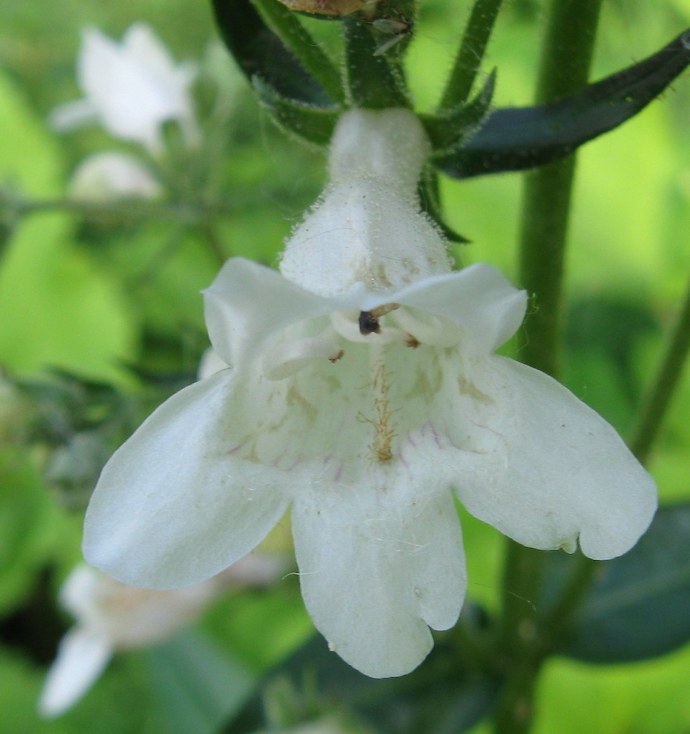
9. Foxglove Beardtongue
(Penstemon digitalis)
Foxgloves are perennial plants that make impressive appearances in early spring and sometimes again in the fall.
This lovely Virginia flower is actually a beardtongue that looks similar to foxglove.
These are clumping plants with lots of foliage at the base, and they send up long stems—up to three feet—that flower in May and June.
These white Virginia flowers are bell-shaped, with deep throats and hairy stamen (the beardtongue) that protrudes to aid in pollination.
Foxglove beardtongues are frequented by several types of bees, and they are found in meadows and open woodlands.
READ MORE: The 10 Best Things to Do in Waynesboro VA (Augusta County)
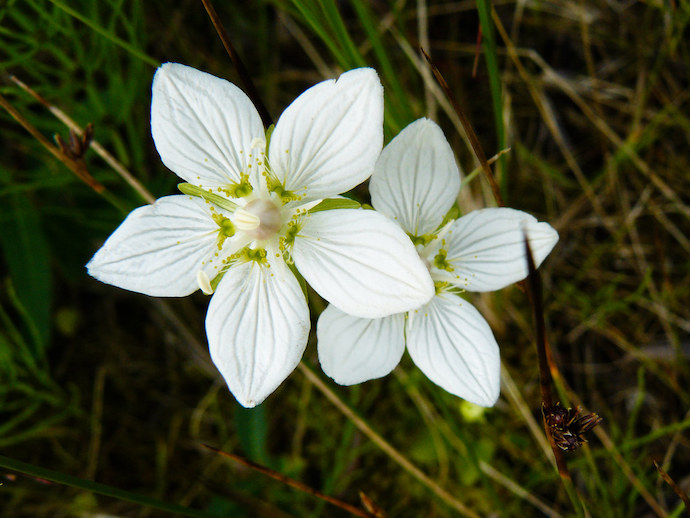
10. Grass of Parnassus
(Parnassia asarifolia)
Native throughout about two dozen counties in Virginia (mostly in the western reaches of the state), grass of Parnassus is a beautiful wetland flower.
Grass of Parnassus is found in lots of eastern states, and it is most at home in moist places such as along stream banks, pond edges, and in swamps and bogs.
The flowers of this plant are white, measure an inch or so across, and have five petals. They form on rounded stems, with a single kidney-shaped leaf.
The blooming season for grass of Parnassus is quite long, typically stretching from mid-summer (July) into mid-autumn (October).
READ MORE: The Best Things to Do at Carvins Cove Natural Reserve in Roanoke VA
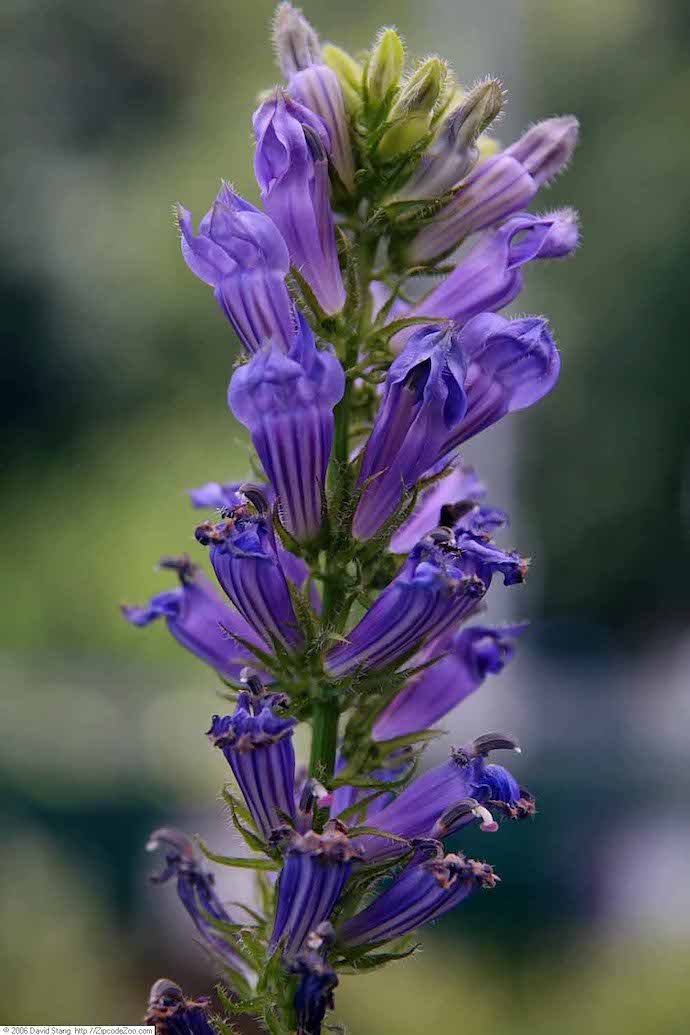
11. Great Blue Lobelia/Cardinal Flower
(Lobelia siphilitica/Lobelia cardinalis)
The great blue lobelia and cardinal flower are of the same ilk. Each is a type of lobelia, with flashy shows of color reflected in their respective names.
The flowers of these native plants in Virginia are trumpet-shaped and ascend densely up rather long stems, which can reach up to four feet under the right circumstances.
Cardinal flowers and great blue lobelia are both wetland plants, preferring soil that stays rather saturated, and they are often seen growing side-by-side.
Hummingbirds are great fans of these gorgeous flowers and are particularly attracted to the red of the cardinal flowers. They bloom in the summer and can last quite a while.
READ MORE: The 8 Best Breweries in Roanoke VA, the Heart of Virginia’s Blue Ridge

12. Green-Headed Coneflower
(Rudbeckia laciniate)
Coneflowers are common in cultivated gardens, and we also know them as echinacea in our herbal teas and medicines. But they are considered wildflowers in Virginia.
The green-headed coneflower can be a spindly giant. They reach up to 10 feet tall in rare instances, with flowers that can measure up to four inches across.
Green-headed coneflowers have green centers with yellow leaves, and they appear in summer and autumn.
These yellow Virginia wildflowers like sun and space, so they grow well in meadows, where they attract butterflies and songbirds such as golden finches.
READ MORE: The 10 Best Things to Do in Luray VA (Gateway to Shenandoah)
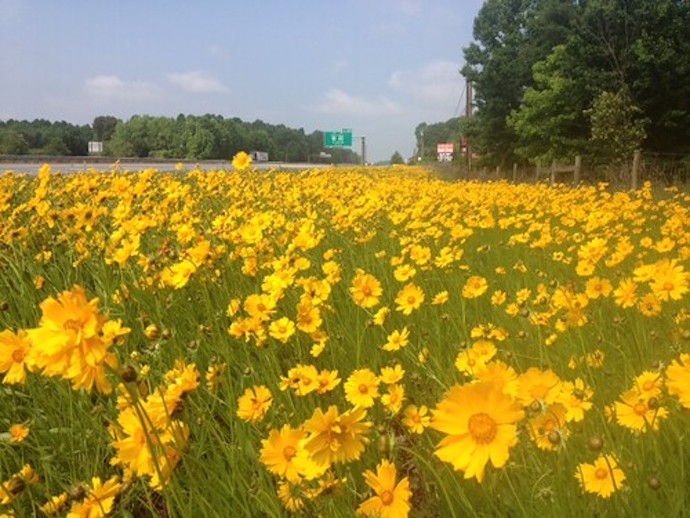
13. Lanceleaf Coreopsis
(Coreopsis lanceolate)
Blessed flower fields are home to the lanceleaf coreopsis, a perennial wildflower that blooms bright yellow and can paint the landscape in late spring.
Coreopsis species are often gardener favorites because they’re easy to grow, spread readily, and make brilliant displays. But they’re considered native Virginia and North Carolina wildflowers.
The flowers can be as large as two inches across, with four lobes and a disc-like shape. They perch atop long stems.
These colorful flowers are mostly likely to be found in prairies, fields, and along roadsides where trees are kept at bay.
READ MORE: Exploring the Blue Ridge Music Center, Galax VA (Blue Ridge Parkway MP 213)
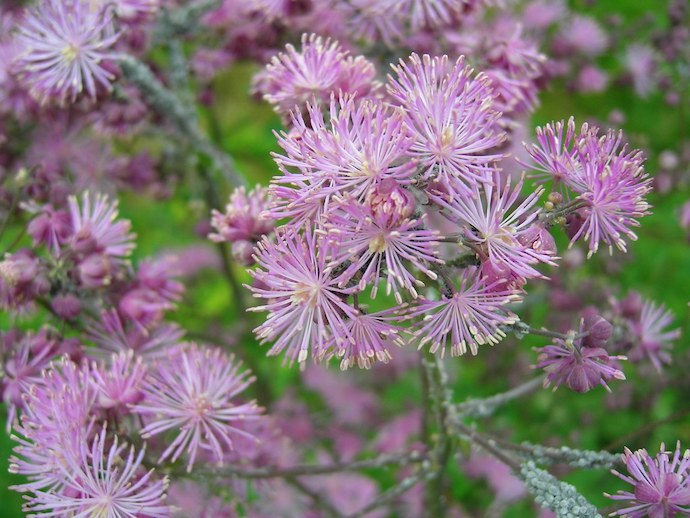
14. Meadow Rue
(Thalictrum aquilegiifolium)
Different from the culinary herb known as rue, meadow rue is a Virginia wildflower that can be equally appreciated for its greenery (if not more so).
Growing in the forest understory, these plants have a leaf structure similar to ferns. There’s a large stem that has smaller stems, each of which has 9 small leaflets on them.
The leaflets of meadow rue are rounded, and resemble the leaves of columbine.
Meadow rue flowers come out in the springtime. They have thread-like lavender petals with yellow tips and yellow centers, creating pom-pom-like blooms.
There are several types of meadow rue growing in Virginia, but this one is a unique pleasure to find.
READ MORE: Visiting Mill Mountain Park & the Roanoke Star in Roanoke VA

15. Nodding Ladies’ Tresses
(Spiranthes cernua)
A type of orchid often found in swamps and bogs, nodding ladies’ tresses is native to the eastern US and is another native Virginia flower.
Ladies’ tresses spread slowly via rhizome to form colonies. They send up spike-like stems of up to 18 inches that are covered in small white flowers.
The flowers only measure about 1/3-inch long, and they have three white petals and three white sepals, the top two of each somewhat merging together to form a hood over the bottom ones.
They are common in swampy meadows, moist fields, and marshes, providing great fall blooms that often last right up until the year’s first frost.
READ MORE: The 7 Best Restaurants in Roanoke VA (Virginia’s Blue Ridge)
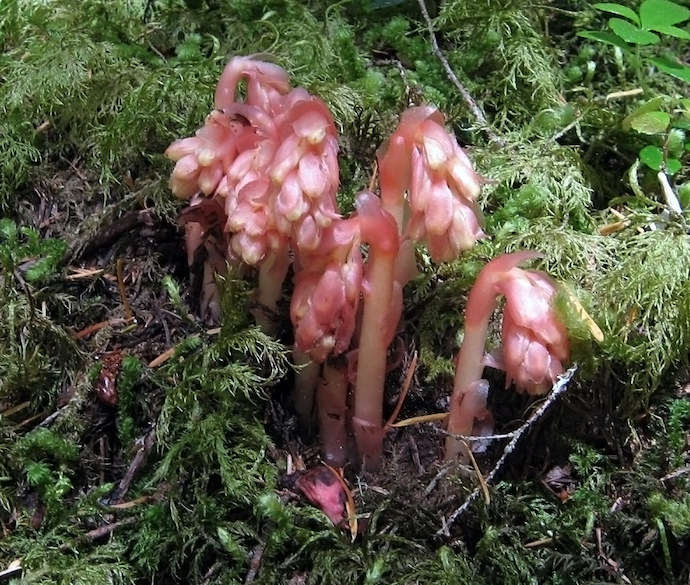
16. Pinesap
(Montropa hypopithus)
Somewhat of an anomaly in the plant world, pinesap is a flowering plant that does not use photosynthesis. Instead it gets its energy from organic matter in forest soils.
Plants that do this (there’s another called Indian pipe or ghost pipe) are classified as myco-heterotrophic. They are often confused with fungi, but they are considered flowers.
Pinesaps bloom in late Summer and early Autumn, with the color of the flowers moving from creamy yellow to pinkish red as the seasons progress.
They’re found in damp forested areas, and they are usually seen popping up from the beneath layers of leaf litter.
READ MORE: The Best Restaurants in Lexington VA & Natural Bridge VA for Foodies
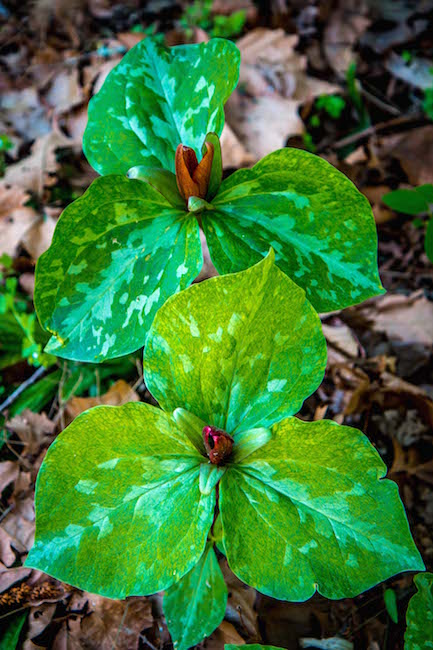
17. Trillium
(Trillium spp)
Trillium are some of the most alluring flowers found throughout the Blue Ridge Mountains, and they show themselves in numerous colorful variations.
Trillium flowers are abundant throughout the eastern US. There’s yellow trillium, white trillium, purple trillium, red trillium, painted trillium, toadshade trillium, and so on.
Each variety produces scapes (stems) that grow from an underground rhizome, has three broad bracts (leaf-like parts) on the individual scapes, and a single, three-petaled bloom per stem.
These are common flowers to find when you’re hiking in the forest, particularly in areas with abundant moisture, like most Virginia mountains.
READ MORE: Exploring the Virginia Museum of Transportation in Roanoke VA
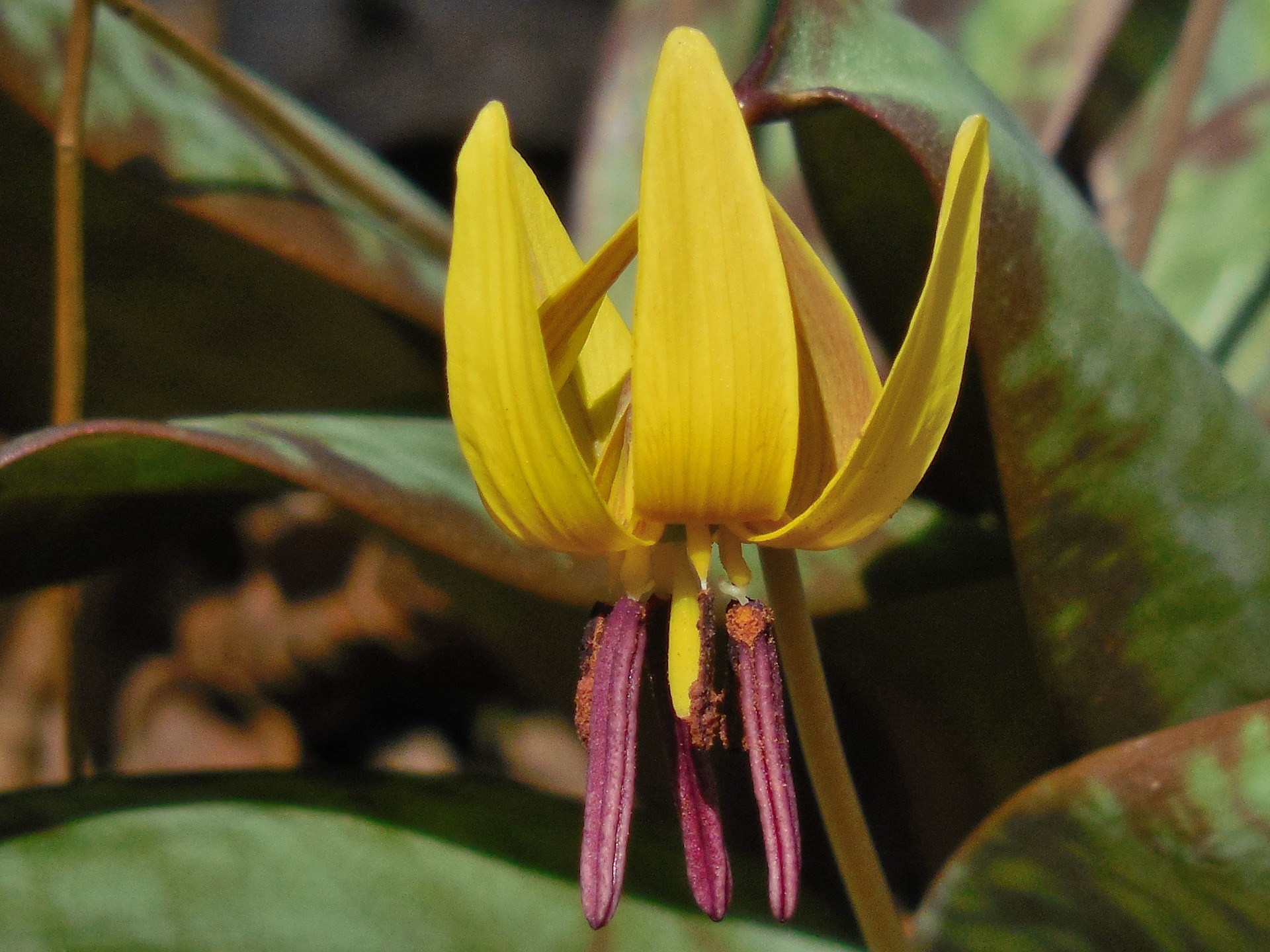
18. Trout Lily
(Erythronium americanum)
Trout lilies grow low to the ground and emerge in early spring. One of the most beautiful yellow wildflowers in Virginia, they’re finicky bloomers that need good afternoon sun in order to fully show their stuff.
Sometimes known as the dog-tooth violet, trout lilies form colonies that can cover a forest floor in the early spring. They like wet spots with ample sunlight.
The flower is rather timid, its stem growing only a few inches up from the ground. But the blooms are stunning for those who take the time to notice.
Trout lilies get their fishy name from their leaves, rather than the flowers. The leaves are dark and dotted with brown spots, making them resemble a brook trout.
READ MORE: Things to Do at Center In The Square in Downtown Roanoke VA
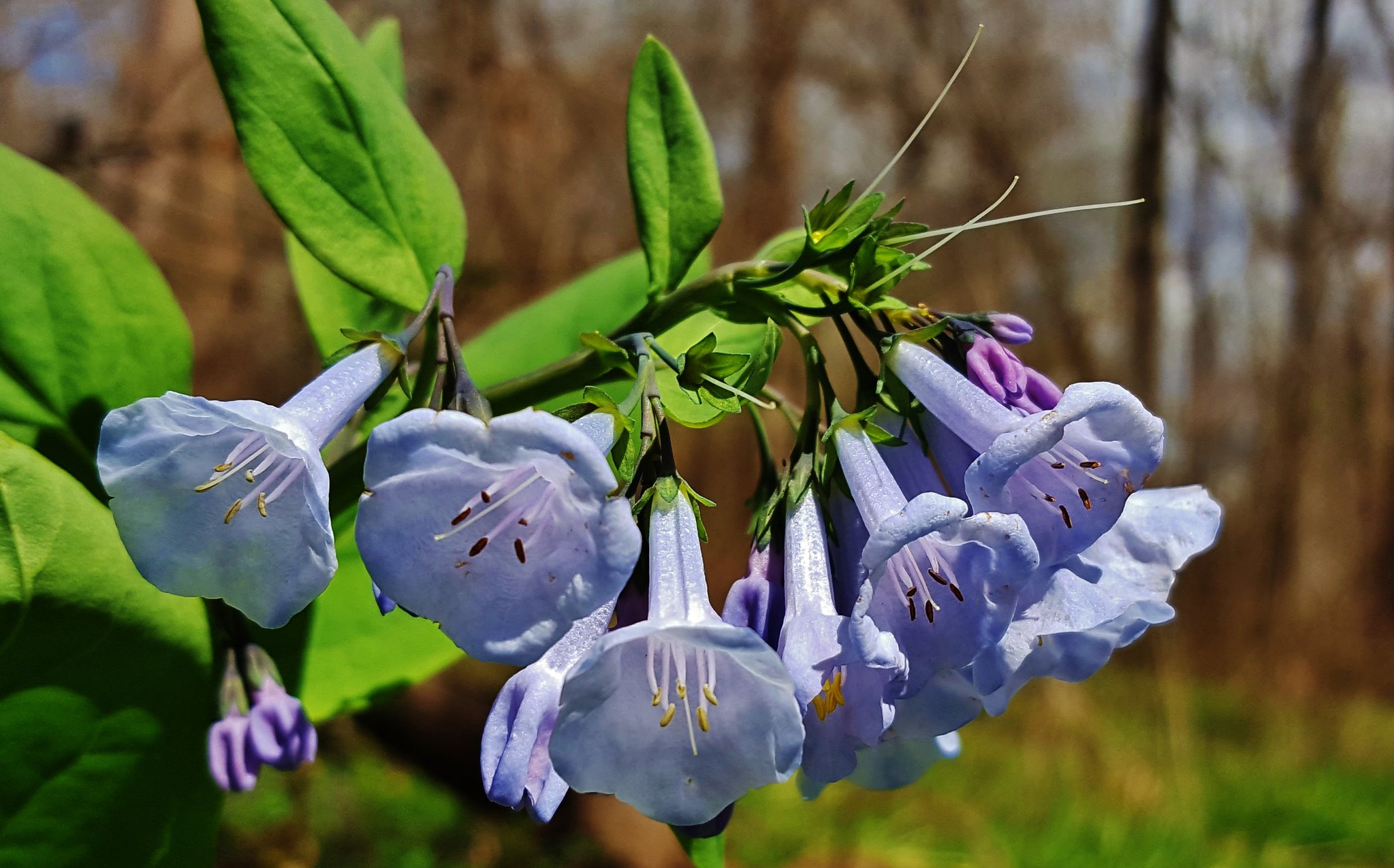
19. Virginia Bluebell
(Mertensia virginica)
Also known as Roanoke bluebells and Virginia cowslip, Virginia bluebells are stunning native Virginia wildflowers.
They can be pink or purple, but, as the name suggests, they’re best known as a beautiful blue wildflower in Virginia.
Though the color of the flower may vary, the buds of Virginia bluebells are always pink. Then, when it’s time to pollinate, an increase in alkalinity typically changes the blooms to blue.
These are spring flowers that come out in March or April, and usually found in wet woodlands or shady floodplains.
Like daffodils, these are ephemeral flowers, blooming in the spring and then disappearing into dormancy until the following year.
READ MORE: The 15 Best Treehouse Rentals in the North Carolina Mountains

20. Whorled Wood Aster
(Aster accuminatus)
This perennial Virginia flower enjoys life in the woods, and it’s one of the few blooms you might find on the forest floor in late summer.
Whorled wood asters offer an alluring combination of colors. Dainty white petals bow out from pink centers, with flashes of yellow protruding from them.
These native Virginia flowers grow up to three feet tall, and the foliage is quite prominent, with little blooms poking out of the top.
Whorled wood asters are most commonly found in high elevations, such as Grayson Highlands State Park and the Mount Rogers National Recreation Area. –Jonathon Engels; lead image of Groundhog Meadow Overlook on the Blue Ridge Parkway by Bret Love & Mary Gabbett

